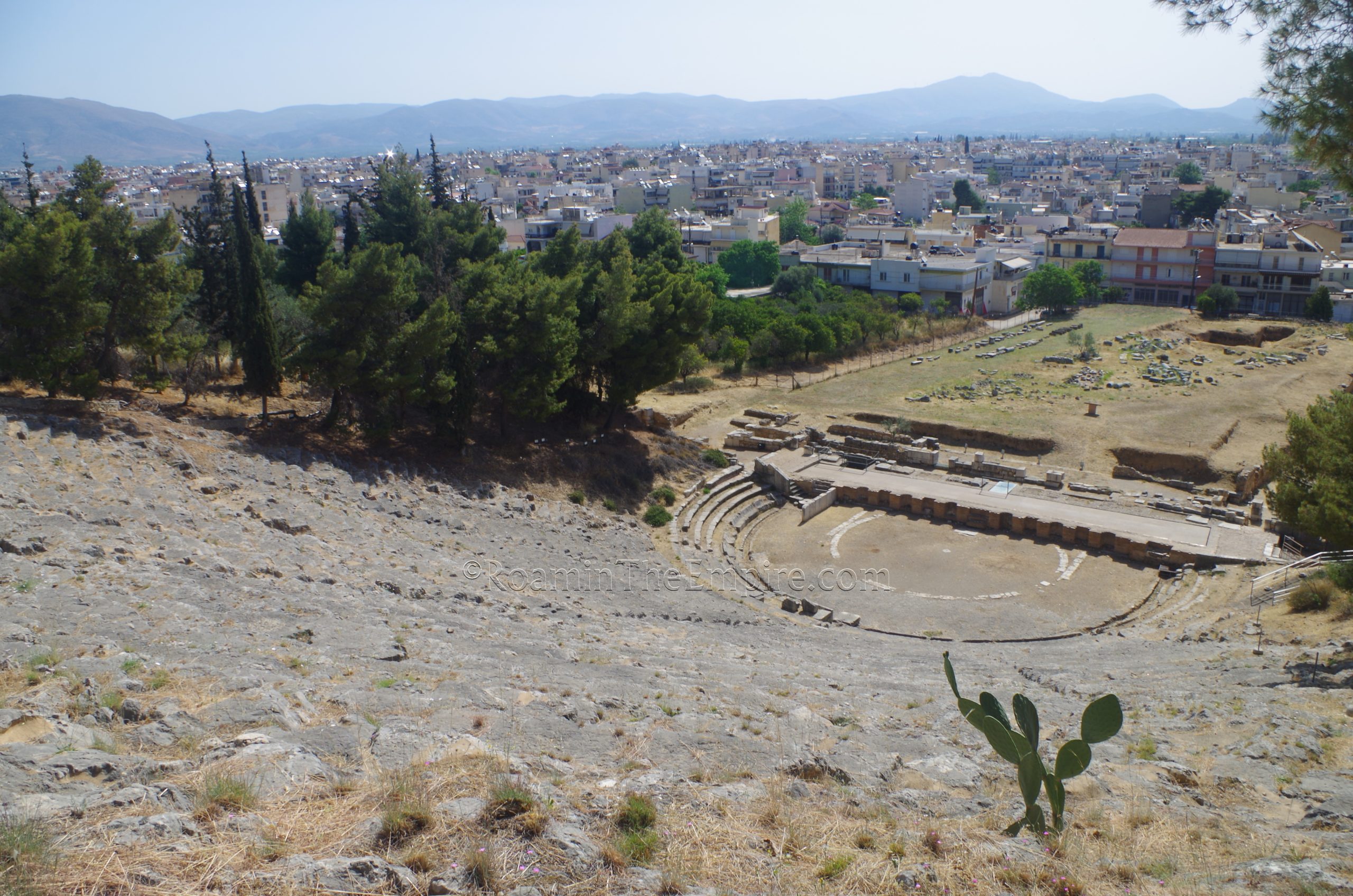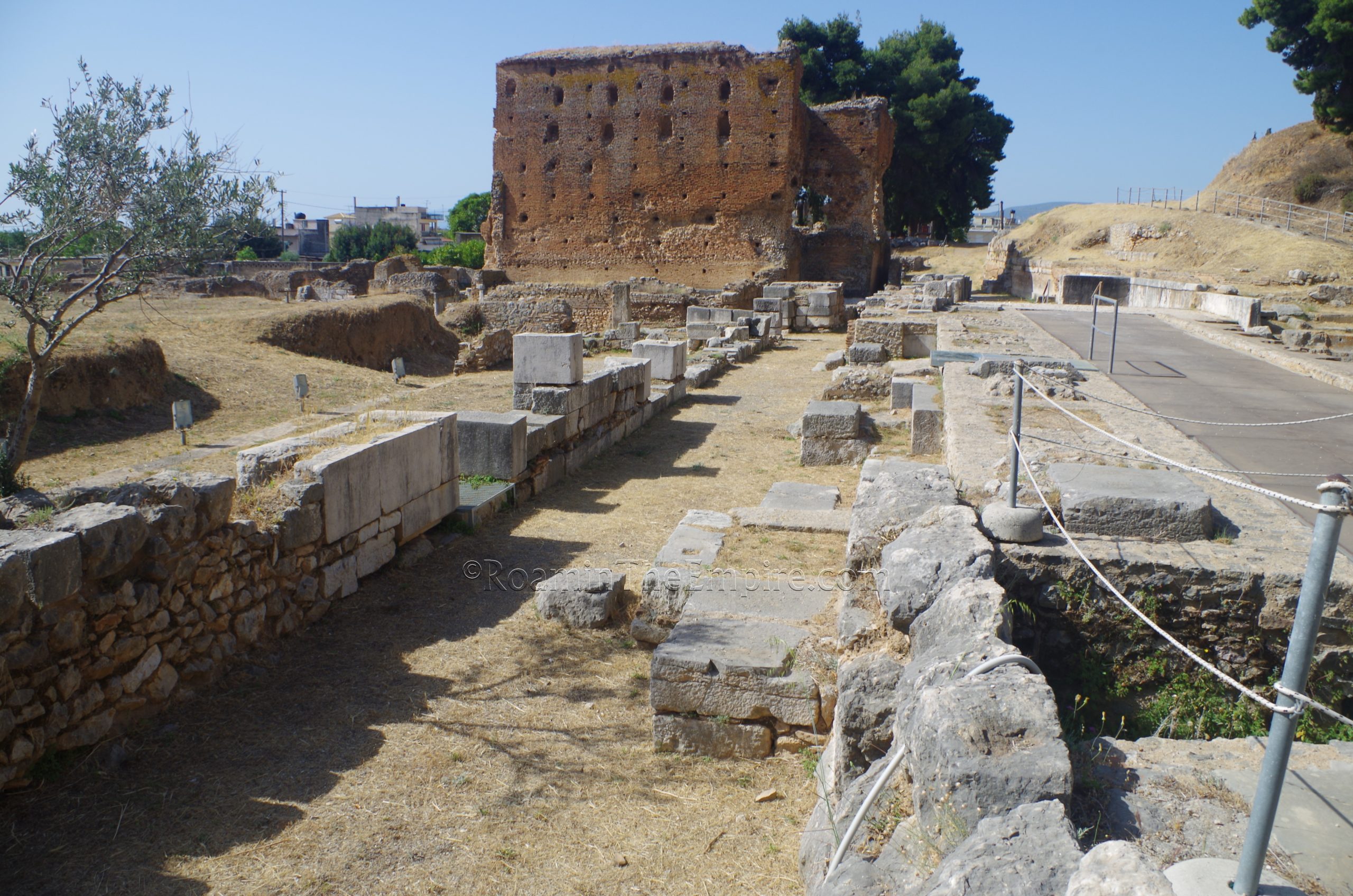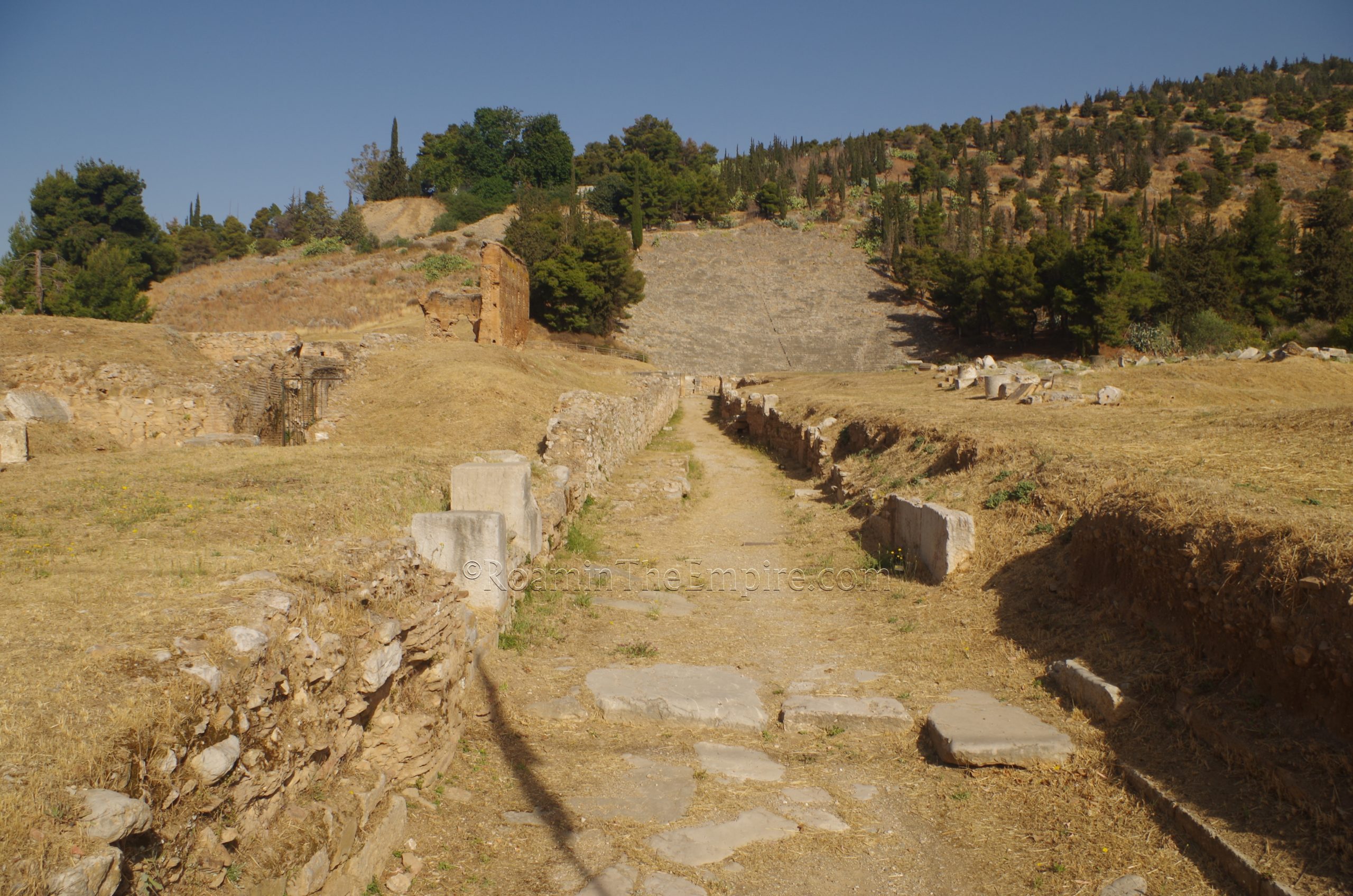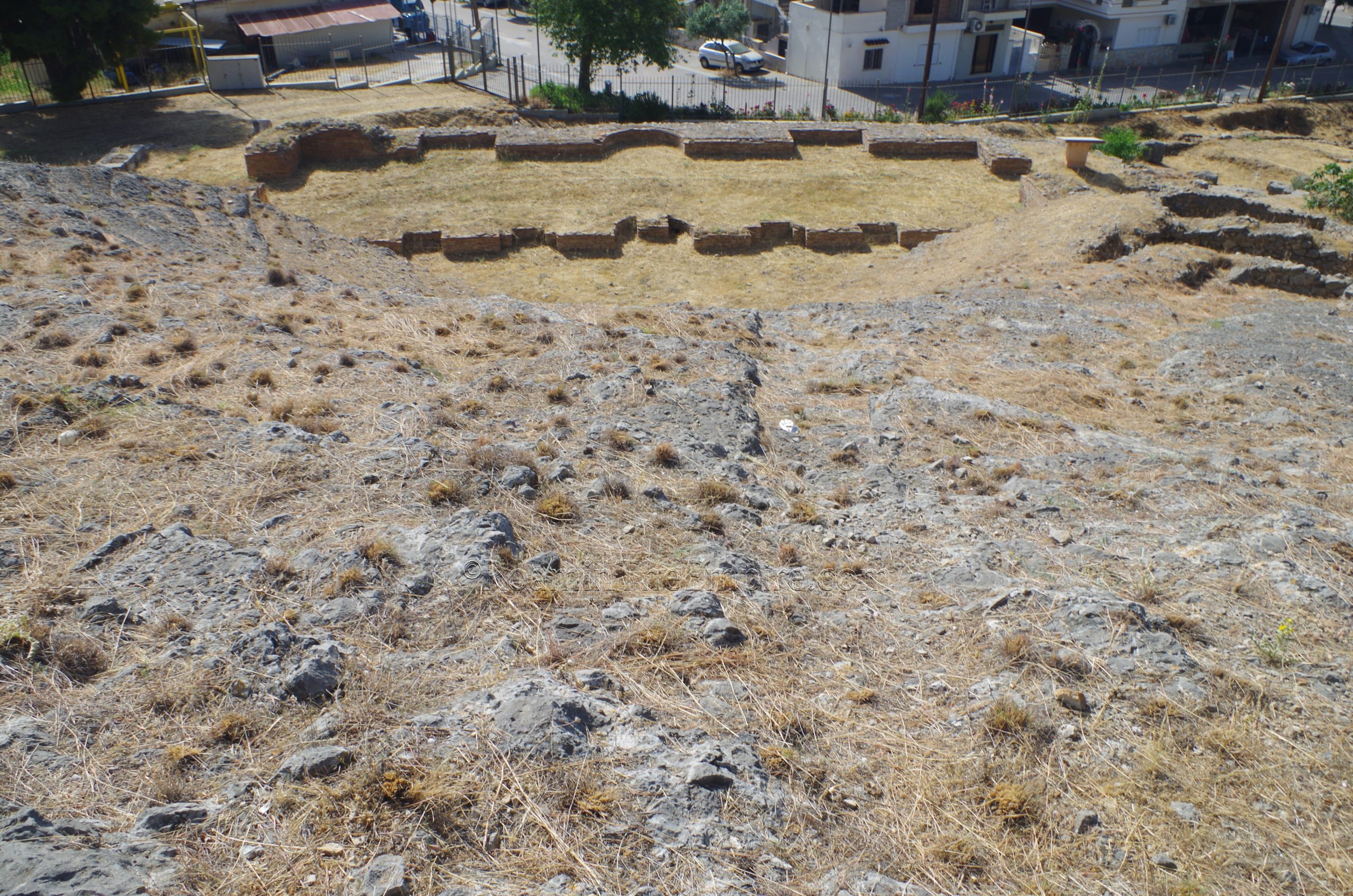
Most Recent Visit: May 2021
The area of the present day and ancient city of Argos seems to have been one of the longest continually inhabited locations in Greece, frequently attributed as one of the most ancient cities and with archaeological evidence suggesting habitation dating back to the 8th millennium BCE. Argos was said to have been founded by the Pelasgian king Inachus or his son Phoroneus, after whom it was briefly named before the latter’s son, Argus, named it after himself when he came to power. The city then gave its name to the fertile plain and peninsula on which the city stands adjacent. The original Pelasgic population of Argos seem to have been replaced by Achaens at some point, who were then subsequently replaced by Dorian rule during the migrations around the 13 century BCE. Argos was said to be the origin of the Macedonian Argead dynasty, founded in the 8th century BCE and of which Alexander the Great would later be a member.
Argos was, along with Sparta, one of the dominant powers on the Peloponnese. The city seems to have even eclipsed Sparta for a period of time following a victory over the Spartans at the Battle of Hyssiae around 669 BCE. This period of dominance came to an end following a costly defeat by the Spartans at the Battle of Sepeia in 494 BCE. This resulted in a period stagnation and the transition to democracy for Argos. It also seems to have played a role in Argos’ not joining the PanHellenic alliance against the Persians in 480 BCE, which considerably damaged the reputation of the city among the Greeks and lead to allegations they had been bribed by the Persians to remain neutral. Argos did consolidate power on the Argolid in the years following, destroying Mycenae in 468 BCE and likely a host of other settlements around the same period.

Argos allied with Athens and Thessaly against Sparta in 461 BCE, but within 10 years, the alliance had fallen apart, perhaps in part to Argive unwillingness to contribute significant forces to the military actions. About 460 BCE, the Nemean games were moved temporarily moved to Argos, which hosted them for a period of time, but then later administered the games. At the outbreak of the Peloponnesian War in 431 BCE, Argos at first remained neutral, but following the Peace of Nicias, formed an alliance against Sparta that eventually included support from Athens. A few years later at the Battle of Mantinea in 417 BCE, the alliance was dealt a strong defeat by Sparta and a pro-Spartan oligarchy was able to briefly seize power in Argos. Argos would continue to intermittently support various entities fighting against Sparta.
During the Macedonian hegemony in Greece, Argos remained unoccupied, but had transitioned from a democratic government to rule by Tyrants. It became a target of Pyrrhus of Epirus, after a failed attempt to install Cleonymus to the Spartan throne in 272 BCE, when Aristeas of Argos sought the general’s help in overthrowing the government in Argos. Aristeas opened the gates for Pyrrhus at night, but the Argive militia, with support from a nearby Macedonian army and Spartan contingent, was able to rally against the deception. In the ensuing defeat, Pyrrhus was killed, possibly by a falling or thrown roof tile according to some sources. In 270 BCE, the Nemean games were permanently moved to Argos. Argos initially supported the Antigonids against the Achaean League, but after a string of Achaean successes, joined the league in 229 BCE.

After the Macedonians allied themselves with Hannibal against Rome and Rome essentially backed the Aetolian League as a proxy against the Macedonians, Argos and the rest of the Achean League aligned themselves with Macedon against the Aetolian League and their allies, including Sparta. After a treaty concluded this engagement, the Social War, in 217 BCE, the Romans made overtures to the non-Achaean League states of the Peloponnese to support Rome against Macedonia, of which Sparta was included and hostilities between Sparta and Argos were effectively renewed. By the start of the Second Macedonian War in 200 BCE, things had once again flipped, with Sparta supporting Macedonia and the Achean League, under duress, supporting the Romans.
With the Achaean League’s defection to Rome, the Macedonians had only Corinth still in their possession. Unhappy at betraying the Macedonians, after a Roman siege of Corinth was broken by the Macedonian general Philokles, the Argives rose up and with the help of the Macedonian general, defected to the Macedonian side and expelled their Achaean garrison. Unable to maintain their own troop garrison at Argos in light of a pending Roman offensive in 198 BCE, the job was farmed out to the Spartans. After taking possession of Argos, the Spartan king Nabis promptly arranged with the Roman proconsul Flaminius to turn the city over to the Romans in return for negotiating a cessation of hostilities between the Spartans and Achaean League. There was some debate about the fate of Argos, but it remained under Spartan garrison until the end of the Second Macedonian War in 197 BCE.

Following the war, Flaminius famously promised to ensure the freedom of the Greeks at Isthmia and ensured the Romans would depart Greece without leaving behind garrisons. Argos, however, still remained under Spartan control, which caused some concern among the other Greek states. The Romans offered to enforce consensus among a course of action, but declined to rule on the legality of the occupation. The Achaean League took up the offer and with Roman military backing, set upon forcibly removing the Spartan occupation under the command of Pythagoras (not the famed mathematician) who was both Nabis’ son-in-law and brother-in-law. Despite an attempted uprising within Argos, the Roman-Achaean army decided to force the issue by instead putting pressure on Sparta directly, which had the effect of drawing some of the garrison away from Argos and allowing the Argive inhabitants to expel the remaining Spartans in 195 BCE. Argos was then restored as a member of the Achaean League until it was dissolved after the Roman conquest of Greece.
By the time of Roman conquest or shortly before, Argos was one of the largest cities in Greece with perhaps as many as 100,000 inhabitants divided equally among citizens and non-citizens. The city was prosperous through until the 3rd century CE, when, like many other cities in Greece, was subject to increasing barbarian incursion. Argos was among the cities sacked by the Heruli in 267 CE. Argos seems to have again been hit during the Visigoth invasion around 395 CE.
Getting There: Argos is still the primary settlement of the Argolid and one of the bigger cities in the region. Presently there is no railway service to the city, though it does have the infrastructure and supposedly the resumption of service is planned in the near future (as of 2021). Otherwise, it is connected by bus lines to both Corinth and Athens. Departures leave Athens between 5 and 10 times a day (depending on the day and season) along the Athens to Napflio route. The journey takes about 2 and a half to 3 hours and is 11.90 Euro each way. The ride usually stops in Isthmus, so there’s a similar schedule from the area of Corinth at a cost of 5.20 Euro each way. Updated schedules and fares can be found here. A personal vehicle is also a good option in Greece and there is some free street parking near the theater.
There are ample remains from the Roman period in Argos, and those in the main part of the city are conveniently located in a bit of a loop. I started from the theater/agora area as that had some convenient free street parking. The center of town can be a confusing and crowded affair, so avoiding that is a pretty good strategy as well.

Starting a bit south of the theater area (approximately 175 meters south of the entrance to the archaeological area) are some significant remains on the north side of Kipselis Square. The area isn’t very well maintained and it was mostly overgrown with just a few of the taller standing walls poking up above the brush. There are levels of occupation here dating from the 8th century BCE up through the 6th century CE. The oldest periods included burials, while the Hellenistic and later Roman and late antique occupations were residential buildings as well as a road and portico along the western side. There is an interpretive sign with Greek, English, and French explanations, but the first half of the English translation was ruined. About 35 meters up the road, on the opposite side Tripoleos Street, are some covered remains in someone’s yard. They’re visible over the fence when walking by, but are largely obscured by overgrowth and a protective covering. I was unable to find exactly what they were, though.
Heading back north is the archaeological area of the theater located at Gounari 153, but essentially at the crossroads of Tripoleos, Theatrou, and Gounari streets. The archaeological area is open daily from 8:30 to 16:00. Admission is 3 Euros and includes access to the area of the agora across the street.

Three primary areas make up the archaeological area of the theater. From the entrance, remains of a road run straight up to the theater with a largely unexcavated area on the right (north) and a bathing complex on the left (south). In the 2nd century BCE, a Serapeum was constructed in the area that now makes up the western part of the baths. By about 100 CE, the sanctuary was expanded to include a large, porticoed courtyard that extended eastward over remaining area of the bath complex. During the reign of Hadrian, some bathing facilities were built and dedicated to Asclepius, who seems to have supplanted Serapis for worship at this location, as noted by Pausanias. In the late 2nd or early 3rd century CE, the sanctuary was completely converted to a bath complex which remained in use until the 5th or 6th century CE, at which point it was abandoned.
Though not all of the baths are completely accessible, most of the complex can be accessed. The best preserved part of the baths is perhaps the large hall in the west, described as the basilica thermarum. The walls here preserved at places to nearly the ancient roof level, with some of the vaulting along the edges visible at a height of over 10 meters. This area made up the core of the original Serapeum. A small crypt beneath the apse of this hall has been revealed in which three sarcophagi were found, and presently remain in situ. The function of this feature does not seem to be known. Some water elements are visible south of the southernmost of these rooms, including a tank and some channels leading into the baths.

The large hall opens into a series of three smaller rooms that were also originally associated with the sanctuary of Serapis, but didn’t serve any specialized function with the baths. These then lead into a wide room with a bunch that probably served as the apodyterium. Two transitionary rooms on either end then lead down around cold pool and into the large frigidarium. In addition to the pool between the entrances, there are also pools at either end of the frigidarium that would have had columns in front of them, as evidenced by the remnants of columns and in situ bases. Some mosaic flooring can be seen around the edges of this room. At the north end of the frigidarium is an entrance to a small room that originally seems to have been latrines. At the center, the frigidarium opens into a small room that then gives way to the heated portions of the baths, though direct access to these rooms is limited due to the height difference; as much of the floor and hypocaust system is missing. Some of it is still present and a portion is reconstructed in the room to the south/southwest. All the heated rooms are described as caldaria, though at least one should have been a tepidarium, perhaps the south/southwestern of these.
There is also access along the south side of the baths with some views of the cryptoporticus that ran along this side of the complex, as well as the column bases that were elements of the portico. This then leads to an area around the south/southeast part of the baths. Some constructions here were apparently associated with the palaestra. Though gates prevent access, the north cryptoporticus, as well as elements of the third heated room can be seen from here.

To the northwest of the baths is the ancient theater of Argos. The theater here was originally constructed during the first half of the 3rd century BCE, with the cavea and orchestra areas hewn from the rock of the hill. The 89 rows of seating could accommodate about 20,000 spectators. Dramatic contests for the Nemean Games were held in this venue. Major renovations were carried out in the early 2nd century CE, which included expansion and embellishment of the scenae structure to create a more Roman design. At some point, barrier elements were installed to separate the cavea from the orchestra in order to accommodate venationes. Further renovations were carried out in the 3rd and 4th centuries CE, with the latter including hydraulic elements such as a water tank and drainage for the hosting of water spectacles. By the 5th or 6th century CE, the theater seems to have fallen out of use.
The theater is pretty much open with no restrictions on access. One can climb up to the top of the cavea, which gives pretty fantastic views of the site and the surrounding area. There is a gate on the north side, about midway up, which leads to the nymphaeum to the north. The gate, however, is locked and there is no direct access allowed from the site, though it can be accessed from outside the site. Post holes among the cavea were constructed as part of Roman renovations in order to support a canopy that shaded the audience. The orchestra had a unique feature (only identified in one other theater), an underground passageway for the use of chthonic deities in productions. Another point of note is a relief of two horsemen located on the retaining wall just south of the actual theater.

About 80 meters south of the theater is the odeon. Between the theater and odeon are some elements of the aqueduct that brought water to the theater can be seen. The odeon originally served as the location for an earlier theater dating to the 5th century BCE, which may have served as a bouleuterion. Like the larger theater, the smaller theater had rock cut seating, though it was arranged in straight rows rather than the semicircular pattern familiar with most theaters. There was also room for only about 2,500 spectators. After the construction of the larger theater, this one largely fell out of use. In the late 1st century CE, the seating was reconstructed into a semicircular form and it was enclosed to form the odeon. This venue was used for poetic and musical competitions associated with the Nemean Games. In the 3rd century CE, major renovations were carried out, changing the form of the odeon and adding supports to create extra seating to the left of the state. This renovation also included new facing on the cavea and mosaics in some areas, including the floor of the orchestra. This form of the odeon seated about 1,800 people.

Like the theater, most of the area of the odeon is open and accessible. It’s kind of hard to see, but the straight seating of the original theater is visible outside the limits of the semicircular seating of the odeon. Also the supports for the 3rd century CE seating to the left of the stage can be seen. South of the odeon is the final area of the park, the sanctuary of Aphrodite. Evidence of Aphrodite worship at this location dates back to the 7th century BCE, and the original sanctuary terrace was constructed in the 6th century BCE along with a temple. The temple remains present today date to about 430 BCE. The sanctuary was reconstructed and enclosed during the Hellenistic period and continued to function until the 5th century CE, when it was destroyed and abandoned. This area is a bit confusing as there are a number of hydraulic features criss-crossing the space. Part of the eastern extent of the temple is visible as well as some elements of the Hellenistic enclosure. It is a little difficult to decipher at ground level, but satellite images clear it up a bit.
The park is pretty well presented. Access is fairly extensive and is really only areas that present physical danger are restricted. Lots of signs are present with diagrams, illustrations, and text in English, Greek, and French.
Sources:
Diodorus Siculus. Bibliotheca Historica, 11.65, 12.75.
Grant, Michael. A Guide to the Ancient World: A Dictionary of Classical Place Names. New York: Barnes & Noble Books, 1997.
Hall, Jonathan M. Reclaiming the Past: Argos and Its Archaeological Heritage in the Modern Era. Cornell, NJ: Cornell University Press, 2021.
Herodotus. Historiai, 6.76-6.85, 6.92. 7.148-7.150.
Homer. Illiad, 4.51-52.
Livy. Ab Urbe Condita, 32.25. 34.25-34.41.
Longfellow, Brenda. “The Legacy of Hadrian: Roman Monumental Civic Fountains in Greece.” The Nature and Function of Water, Baths, Bathing, and Hygeiene from Antiquity through the Renaissance. Leiden: Brill, 2009.
Miller, Stephen G. “The Date of the West Building at the Argive Heraion.” Archaeology. Vol. 77, No 1 (Jan. 1973), pp. 9-18.
Pausanias. Hellados Periegesis, 2.15.5, 2.17, 2.19.3-2.24.4, 2.25.7, 2.26.1, 2.35.2, 8.27.1.
Plutarch. Aratus, 34-35.
Plutarch. Pyrrhus, 34.
Polybius. Historiai, 2.44, 2.52-2.54. 2.70.
Smith, William. Dictionary of Greek and Roman Geography. Walton & Murray, 1870.
Stillwell, Richard, William L. MacDonald, and Marian Holland. McAllister. The Princeton Encyclopedia of Classical Sites. Princeton, NJ: Princeton U Press, 1976.
Strabo. Geographika, VIII.5-6.
Thucydides. Historiai, 4.133, 5.14, 5.29-5.82.
Tomlinson, R.A. Argos and the Argolid: From the End of the Bronze Age to the Roman Occupation. New York: Routledge & Kegan Paul Ltd., 1972.
Xenephon. Hellenica, 7.5.5.


